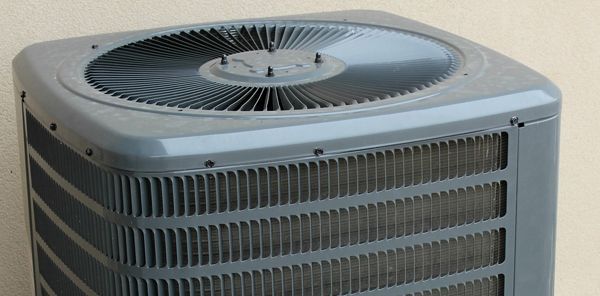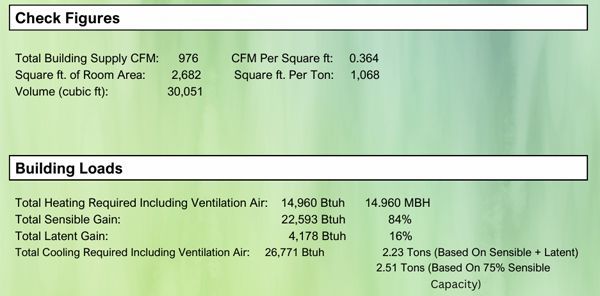Blog

By Dennis Stroer
•
08 Feb, 2024
Why Are My Windows Sweating? In our latest blog, we explore indoor humidity management during winter, focusing on modern construction challenges and solutions like dedicated dehumidification systems. Read the post for valuable insights into maintaining optimal indoor comfort.
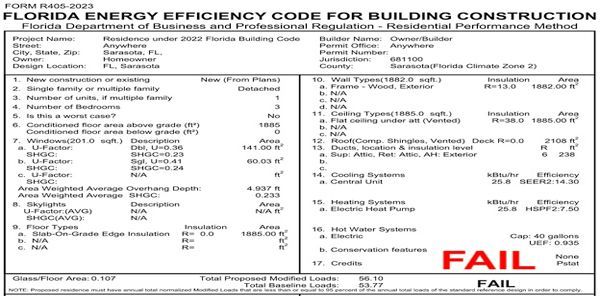
By Elizabeth O’Keefe
•
04 Dec, 2023
The next iteration of Florida Building Code, Energy Conservation, will go into effect at midnight on December 31, 2023. With the 8 th edition of the Florida Building Code (FBC) comes the expectation that residential buildings will become 5% more energy efficient. To date, residential buildings have been considered code compliant with a 100 or better estimated Energy Performance Index. Beginning January 1st, 2024, at 12:01 a.m., residential buildings will need an estimated Energy Performance Index of 95 or better to pass with the 8 th edition of the FBC. To illustrate the upcoming energy related code changes, an 1885 sq ft example building that passes the 7 th Edition of FBC Energy Conservation will be shown and compared under the 8 th Edition of the code. 2022 7 th edition energy performance level (EPL) display card (Note passing index under FBC 7 th edition) .
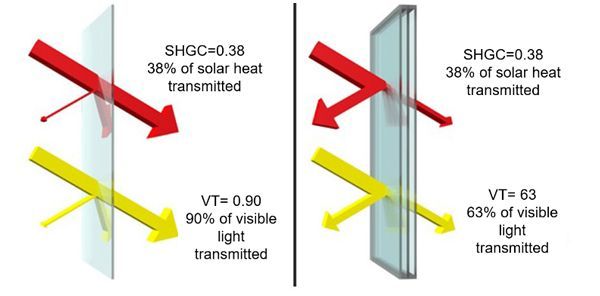
By Dennis Stroer
•
14 Nov, 2023
We like windows in our homes. Windows provide some curb appeal, they let light into our homes, and they make us feel closer to the outdoors and nature. Windows can either be energy hogs or they can be very energy efficient. Window ratings tell us how much conductive heat, radiant heat and visible light is being transferred into our homes. Let’s try to understand the meaning of the three rating numbers. Windows have two values that represent heat transfer and one value that represents light transfer. U-value and the SHGC (solar heat gain coefficient) represent heat transfer and VT (visible light transmittance) represents light transfer. The U-value measures how effective a material is as an insulator, resisting the flow of conductive heat. The SHGC is a measure of how much of the sun’s rays comes through the glass heating objects in the home. In both cases, the lower the number, the better. In simplistic terms, a U-value of 1.0 means that the material has no resistance and 100% of the heat is transferred through the Material – think of a frying pan on a hot plate. If the U-value is 0.5, 50% of the energy is transferred across the material. Preventing radiant heat through windows is most important when it comes to keeping air conditioning costs low. All windows let in a certain amount of radiant heat. Radiant heat is the heat you feel when standing in front of a bonfire on a cold day. If there is nothing between you and the fire, you can feel the heat. As soon as another person stands between you and the fire, the radiant heat is blocked, and the other person is getting of all the heat. Windows allow the radiant heat to come into the home and heat up items such as tables, chairs, all other furniture and additional objects in the room. These items are storage devices for heat and begin to radiate heat back to the occupants in the home. Windows with the right coating can reflect most of the radiant heat back outdoors before it can enter the inside of the home.
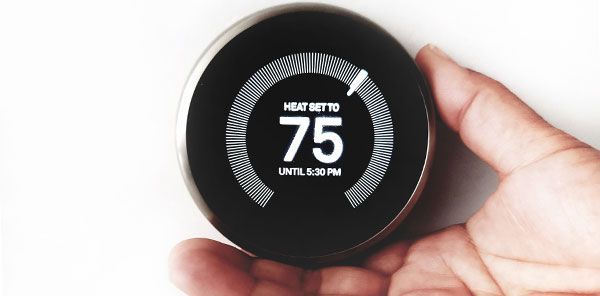
By Lauri Gambino
•
31 Jul, 2023
When people have a new home built, they want it to be pleasing to the eyes and comfortable to live in. In both cases, the home buyer already has a perception of what is pleasing to the eyes and what comfort is. One of those comforts, maybe the most important comfort, is the heating, ventilation and air conditioning (HVAC) system. The average home buyer, not familiar with Florida’s hot/humid climate, will want an AC system that will cool the home down fast and to 68 degrees Fahrenheit, if so desired. For two very good reasons, the AC system should not or cannot be sized to cool the home down fast or below 75ºF. The first reason is found in the Florida Building Code-Energy Conservation, Chapter 3, Section R302.1. The section reads “The interior design temperatures used for heating and cooling load calculations shall be a maximum of 72°F (22°C) for heating and minimum of 75°F (24°C) for cooling”. The second reason is more of a durability issue than an energy or code issue. Our design outdoor dew point is 74ºF. This means that any surface lower than 74 ºF will sweat or condense. Consider the can of soda pulled from the refrigerator, the surface of the can begins to condense. The surface temperature of the can is below the ambient dewpoint, the can is a moisture magnet. If the outdoor dewpoint is 74ºF and the inside temperature of the home is 70ºF, there is surely condensation taking place someplace in the building materials. Water vapor condensing into water liquid inside building materials causes rot. It should be noted here, occupants operate their homes at temperatures below 75ºF because the indoor humidity is too high and they perspire. No doubt a bad HVAC system design; bigger is not better. Conclusion: A home built to the minimums of the Florida Building Code is the worse home a builder can build without going to jail. If the HVAC design practitioner designs a cooling system to condition a home to lower than 75ºF, the practitioner is not meeting the intent of the building code. The designer will also be liable for any damages due to the home going into failure because of indoor condensation and rotting building materials. It can be very expensive. The goal of the HVAC system design practitioner is to design an HVAC system that is capable of, at 75ºF thermostat setting, evaporating the perspiration off a person’s body faster than their metabolism can produce it. If this task is met, comfort can easily be achieved at indoor temperatures above the average outdoor dewpoint. Don’t design the home to become a moisture magnet.

By Lauri Gambino
•
31 Jul, 2023
Have you ever found yourself setting your thermostat to a lower temperature because you just couldn't seem to reach the perfect level of comfort at 75 degrees Fahrenheit? Many people operate their homes at low temperatures because at 75°F indoor temperature the humidity gets too high, they begin to perspire. They lower the thermostat a couple of degrees. For the next 30 to 40 minutes, they begin to feel more comfortable. However, after an hour and a half has past, they begin to perspire and the thermostat says its 73°F, so they lower it another couple of degrees. One issue people begin to notice in this scenario, once the cooling system brings the home down to the thermostat set point, the system seems to turn on and run for less than five minutes and turn off and may not come back on for as long as 15 minutes. This indicates that the cooling system is oversized. Oversized cooling systems tend to short cycle and are not able to pull humidity from the air, causing discomfort and reduced efficiency. In this blog post, we'll explore why comfort can't be achieved at 75 degrees Fahrenheit and uncover the secret to ultimate home comfort. The most common reason why people can't find comfort at 75 degrees Fahrenheit is due to equipment oversizing. When HVAC equipment is over-sized, the runtime for normal operation during outdoor design conditions decreases, leading to an adverse effect on indoor comfort. Outdoor part-load takes place for thousands of hours per year, resulting in very short run time with no dehumidification creating discomfort for homeowners. According to ACCA (Air Conditioning Contractors of America) Manual-S, proper equipment sizing is essential to achieving optimal comfort in homes. Oversized cooling systems tend to short cycle and, as mentioned earlier, are not able to pull humidity from the air. This is because the system cools the home down to thermostat set-point too quickly without removing the moisture, leading to high indoor humidity levels and eventual discomfort. With the right-sized system, the HVAC unit will deliver the right amount of cooling and dehumidification needed to maintain a comfortable indoor environment. The goal of the HVAC system design practitioner is to design an HVAC system that is capable of evaporating the perspiration off a person’s body faster than their metabolism can produce it. This means that the system must be adequately sized to handle the specific load requirements of the home. If you can't find comfort at 75 degrees Fahrenheit, your home may require a Manual J load calculation to determine if the sizing is correct. This will help to determine the specific heating and cooling requirements of your home to ensure that your equipment is sized correctly. Conclusion: In conclusion, achieving optimal home comfort at 75 degrees Fahrenheit requires proper HVAC equipment sizing to ensure that the unit runs efficiently and maintains a comfortable indoor environment. Oversized equipment leads to short cycles, high indoor humidity levels, and eventual discomfort. Therefore, if you're having trouble achieving optimal comfort at 75 degrees Fahrenheit, consult with Calcs-Plus to perform a Manual J load calculation to determine if your equipment is sized correctly. Ultimately, the secret to ultimate home comfort is getting the right system for the job.
Location
121 Triple Diamond Blvd, Unit #16
North Venice, FL 34275
© 2024
All Rights Reserved | Calcs-Plus | Terms & Conditions

